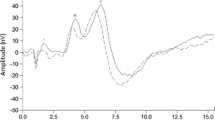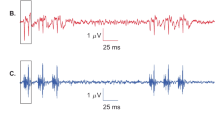Summary
The relationship between changes in loudness and the cochlear whole-nerve potential following experimentally produced deafness was studied in an animal model. Reaction time of a subject's response to an auditory stimulus has been shown to be an index of loudness in human experiments and has been adapted to nonhuman primates. In a series of experiments, four macaque monkeys were operantly conditioned to respond to 8-kHz tones over a range of 0–80 dB SPL, and their reaction times to pure tone stimuli were measured. Whole-nerve cochlear action potentials were recorded from chronic inner-ear electrodes. The relationship between behavioral and electrical measures of loudness recruitment were examined in animals with both temporary and permanent noise-induced hearing loss.
Loudness recruitment was demonstrated experimentally after a 1-h exposure to a high-intensity 8-kHz octave band of noise. Excellent agreement was observed between the reaction time function and the action potential input-output function at intervals of 0.5, 12, 24, 48, and 84 h after exposure.
Permanent hearing loss was produced in some of these animals by a much longer duration of exposure to the 8-kHz octave band of noise. Recruitment was observed in both the behavioral and the electrical measures. Histological studies of these damaged cochleas revealed primarily outer hair cell destruction, with a relative sparing of inner hair cells and nerve supply. The findings of this study are interpreted as strong support for the clinical electrocochleogram as an objective indicator of the presence of loudness recruitment.
Similar content being viewed by others
References
Dix, M. R., Hallpike, C. S., Hood, J. D.: Observations upon the loudness recruitment phenomenon, with especial reference to the differential diagnosis of disorders of the internal ear and VIII nerve. Proc. R. Soc. Med.41, 516–526 (1948)
Eggermont, J. J., Odenthal, D. W., Schmidt, P. H., Spoor, A.: Electrocochleography: basic principles and clinical application. Acta Otolaryngol. (Stockh.) [Suppl.]316, 1–84 (1974)
Fowler, E. P.: A method for the early detection of otosclerosis. Arch. Otolaryngol. (Stockh.)24, 731–741 (1936)
Fowler, E. P.: The diagnosis of diseases of the neural mechanisms of hearing by the aid of sounds well above threshold. Trans. Am. Otol. Soc.27, 207–220 (1937)
Hawkins, J. E., Jr., Johnsson, L.-G.: Microdissection and surface preparations of the inner ear. In: Handbook of auditory and vestibular research methods. Smith, C. A., Vernon, J. A. (eds.), pp. 5–25. Springfield: Thomas 1976
Luscher, W., Zwislocki, J.: A simple method for indirect monaural determination of the recruitment phenomenon (difference limen in intensity in different types of deafness). Acta Otolaryngol. (Stockh.) [Suppl.]78, 156–168 1949
Moody, D. B.: Reaction time as an index of sensory function. In: Animal psychophysics: the design and conduct of sensory experiments. Stebbins, W. C. (ed.), p. 227–302. New York: Appleton-Century-Crofts 1970
Moody, D. B.: Behavioral studies of noise-induced hearing loss in primates: loudness recruitment. Adv. Otorhinolaryngol.20, 82–101 1973
Moody, D. B., Beecher, M. D., Stebbins, W. C.: Behavioral methods in auditory research. In: Handbook of auditory and vestibular research methods. Smith, C. A., Vernon, J. A. (eds.), pp. 439–495. Springfield: Thomas 1976
Pfingst, B. E., Heinz. R., Kimm, J., Miller, J. M.: Reaction time procedure for measurement of hearing I: Suprathreshold functions. J. Acoust. Soc. Am.57, 421–430 (1975)
Portmann, M., Aran, J. M.: Testing for “recruitment” by electrocochleography. Ann. Otol. Rhinol. Laryngol.82, 36–44 (1973)
Pugh, J. E. Jr., Horwitz, M. R., Anderson, D. J., Singleton, E. F.: A chronic implant for the recording of cochlear potentials in primates. Am. J. Phys. Anthropol.38, 351–356 (1973)
Reger, S. N.: Differences in loudness response of the normal and hard-of-hearing ear at intensity levels slightly above the threshold. Ann. Otol. Rhinol. Laryngol.45, 1029–1039 (1936)
Ruben, R. J., Elberling, C., Salmon, G. (eds.): Electrocochleography. University Park Press 1976
Steinberg, J. C., Gardner, M. B.: The dependence of hearing impairment on sound intensity. J. Acoust. Soc. Am.9, 11–23 (1937)
Stevens, S. S.: Neural events and the psychophysical law. Science170, 1043–1050 (1970)
Author information
Authors and Affiliations
Additional information
This investigation was supported by research grants NS-05077, NS-05065 and NS-10854, Program Project grant NS-05786, training grant NS-05679, and Postdoctoral fellowship SF 11 NS-2423-03 to J.E.P. from the National Institutes of Health
Rights and permissions
About this article
Cite this article
Pugh, J.E., Moody, D.B. & Anderson, D.J. Electrocochleography and experimentally induced loudness recruitment. Arch Otorhinolaryngol 224, 241–255 (1979). https://doi.org/10.1007/BF01108782
Received:
Issue Date:
DOI: https://doi.org/10.1007/BF01108782




